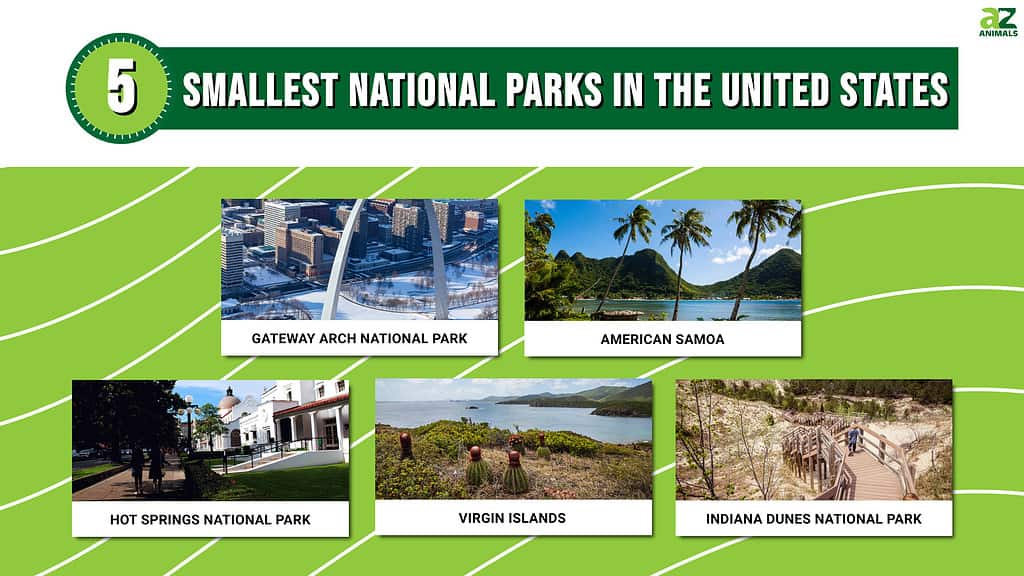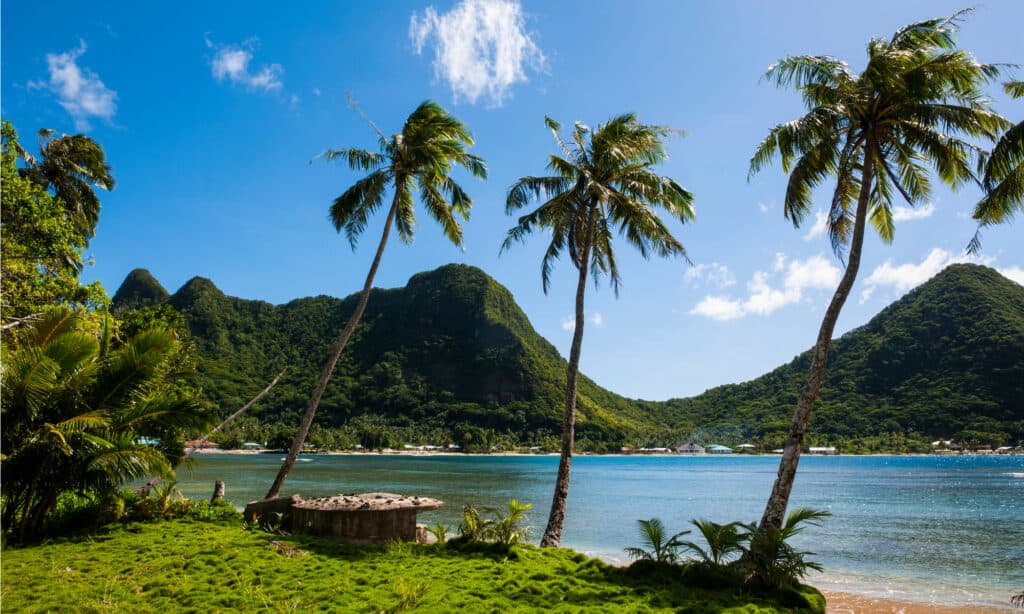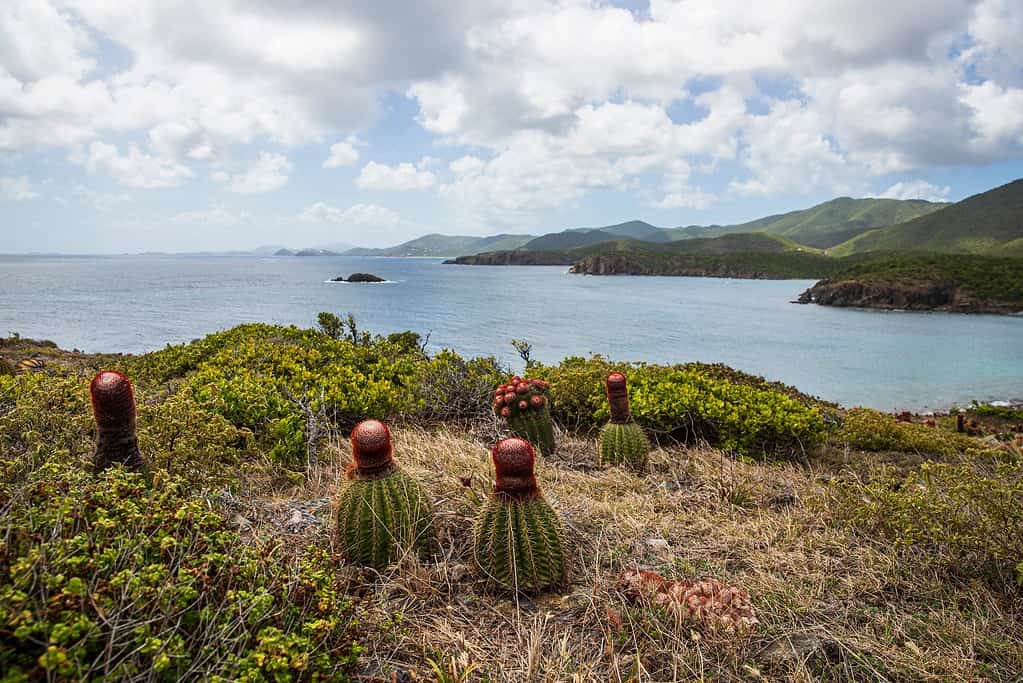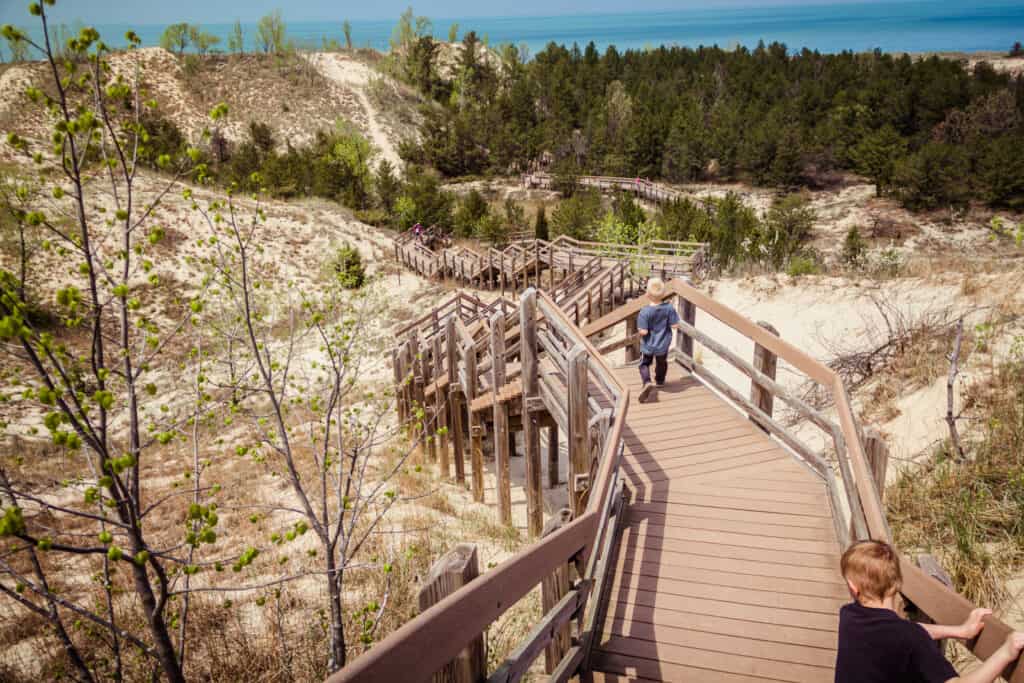
When most people think of national parks, they probably imagine vast expanses of wilderness, towering mountain peaks, dangerous wildlife, and endless trails to explore. However, the United States is also home to some of the smallest national parks in the world, each with its charms and attractions. These parks may not have the size or grandeur of their larger counterparts, but what they lack in scale, they make up for in intimacy and accessibility. Therefore, if you’re looking for a chance to escape the crowds and discover some hidden gems, the smallest U.S. national parks may be just the ticket. Keep reading to discover the five smallest national parks in the United States.
What Is The National Park Service?
The U.S. National Park Service is a federal agency within the U.S. Department of the Interior that is responsible for managing and preserving national parks and other protected areas throughout the United States and its territories. The National Park Service was established in 1916 with the goal of conservation. Today, however, the National Park Service manages over 400 areas, including 63 designated national parks. The National Park Service also manages national monuments, national memorials, national historic sites, and national seashores.
Gateway Arch National Park
The Gateway Arch is a prominent monument located in St. Louis, Missouri, USA. It is the centerpiece of the Jefferson National Expansion Memorial and was built to commemorate the Westward expansion of the United States. Gateway Arch National Park covers 91 acres (37 hectares). The arch stands 630 feet (192 m) tall, making it the tallest man-made monument in the United States. It is also the tallest stainless steel monument in the world. The arch is made up of two legs. Each leg is composed of a series of triangular sections that taper to a point at the top.
Visitors to the Gateway Arch can take a tram ride to the top of the arch. Panoramic views of St. Louis and the surrounding area await them at the top. Visitors ride in small pods that are designed to maintain a level position as they move up the curved arch. The Gateway Arch was designed by architect Eero Saarinen and was completed in 1965. It has become an iconic symbol of St. Louis and a popular tourist attraction, drawing millions of visitors each year.

The Gateway Arch stands 630 feet (192 m) tall, making it the tallest man-made monument in the United States.
©iStock.com/Kent Raney
Nearby Attractions
The nearby Jefferson National Expansion Memorial includes a museum and interpretive center. It tells the story of the Westward expansion of the United States and the Lewis and Clark Expedition. The Old Courthouse is a historic building located just west of the arch. It’s the site of the famous Dred Scott case and now houses a museum dedicated to the history of the St. Louis area. The arch sits on the banks of the Mississippi River, and there are plenty of opportunities to explore the riverfront. Take a riverboat tour, walk, or bike along the Riverfront Trail. Or simply enjoy the views of the river and the city skyline.
Citygarden is a free, open-air sculpture park located just a few blocks north of the arch. It features more than 20 works of art, a splash pad, and plenty of seating areas. The St. Louis Aquarium at Union Station is a popular family-friendly attraction located about a mile west of the arch. It features more than 13,000 aquatic animals and habitats. If you’re a sports fan, catch a Cardinals baseball game at nearby Busch Stadium!
American Samoa
The National Park of American Samoa is a U.S. national park located in the territory of American Samoa in the South Pacific. The park covers three islands – Tutuila, Ofu, and Ta‘ū – and protects coral reefs, tropical rainforests, and Samoan cultural sites. The park is managed by the U.S. National Park Service and provides opportunities for visitors to experience the natural and cultural wonders of American Samoa. The park has over 4,000 acres (1620 hectares) of tropical rainforest that visitors can explore on guided tours or on their own. The rainforest is home to many species of plants and animals, including fruit bats, flying foxes, and the Samoan tree snail.
American Samoa is known for its beautiful beaches, and the park has several that are worth visiting. Ofu Beach is considered one of the most beautiful beaches in the world. Vatia Beach is a great spot for snorkeling. The park is home to many cultural sites that offer a glimpse into Samoan history and traditions. Visitors can tour traditional Samoan villages, learn about Samoan fishing and cooking techniques, and attend cultural performances. Several hiking trails offer stunning views of the islands and the ocean.
Some of the popular trails include the Pola Island Trail on Tutuila Island and the Lata Mountain Trail on Ta‘ū Island. Some of the best snorkeling and diving spots in the South Pacific can be found in the park. Visitors can view a variety of marine life, including colorful fish, sea turtles, and sharks, as they explore coral reefs.

Some of the best snorkeling and diving spots in the South Pacific can be found in the National Park of American Samoa.
©Danita Delimont/Shutterstock.com
Hot Springs National Park
Hot Springs National Park is located in central Arkansas. It was established in 1921 and covers approximately 5,550 acres (2246 hectares). The park is known for its hot springs, which have been used for therapeutic purposes for thousands of years. The park features a number of thermal pools, bathhouses, and other structures built during the late 19th and early 20th centuries when the area was a popular spa and resort destination. Visitors can still relax in the thermal waters at bathhouses in the park, including the Buckstaff Bathhouse and the Quapaw Baths and Spa.
In addition to its thermal features, Hot Springs National Park also contains several hiking trails, including the Hot Springs Mountain Trails, which offer scenic views of the surrounding area. The park is also home to a variety of wildlife, including deer, turkeys, and a number of bird species. Hot Springs National Park is open year-round, and visitors can access its various attractions and amenities through several entrances around the city of Hot Springs. The park also has a campground available for visitors who wish to stay overnight.
Bathhouse Row
There are eight historic bathhouses located in Hot Springs National Park. These bathhouses were built in the early 20th century. At that time the area was a popular spa and resort destination. Of the eight bathhouses, only two are currently open to the public for traditional bathhouse services: the Buckstaff Bathhouse and the Quapaw Baths and Spa. The Buckstaff Bathhouse is the oldest operating bathhouse in Hot Springs and has been in continuous operation since 1912. The Quapaw Baths and Spa is a modern facility that offers a range of spa services in addition to traditional bathhouse services.
Other bathhouses have been repurposed for other uses, such as a visitors’ center, a museum, and a cultural center. The Fordyce Bathhouse is now the park’s visitor center and museum, featuring exhibits on the history and geology of the area. Visitors to Hot Springs National Park can still tour the other historic bathhouses and learn about their history and architecture. Some of the bathhouses also offer interpretive programs and guided tours

Bathhouse Row, Hot Springs National Park.
©Kat Byrd I/Shutterstock.com
Thoroughbred Horse Racing
Oaklawn Racing Casino Resort is just a few miles away from Hot Springs National Park. Oaklawn features thoroughbred horse racing. The Oaklawn racing season runs from January through April. During this time, visitors can watch live horse racing at the Oaklawn track, placing bets on their favorite horses. Oaklawn is well-known in the horse racing world. It has hosted some of the most prestigious races in the country, including the Arkansas Derby, a major qualifying event for the Kentucky Derby.
Virgin Islands
The Virgin Islands National Park is a U.S. national park located on the island of St. John in the U.S. Virgin Islands in the Caribbean. The park covers over 7,000 acres (2833 hectares)of terrestrial habitat, as well as 5650 acres (2286 hectares) of submerged areas. These habitats protect a variety of natural and cultural resources, including coral reefs, tropical forests, and historic ruins.
The park is managed by the U.S. National Park Service and provides opportunities for visitors to experience the natural beauty and cultural heritage of the U.S. Virgin Islands. The park’s diverse habitats, including beaches, forests, and mangrove swamps, provide a home to a wide range of plant and animal species, many of which are found nowhere else in the world. The park is also home to historic ruins of sugar plantations and other structures that provide a window into the island’s past.
The Cinnamon Bay Campground offers tent camping and is located near beautiful beaches and scenic hiking trails. The Cinnamon Bay Campground is located on the North shore of St. John. It has over 120 tent sites, as well as a beach, a restaurant, and a small store. The campground also offers kayak and paddleboard rentals, as well as a variety of educational programs and ranger-led activities. The campground is operated by the park and offers basic amenities, such as restrooms, showers, and picnic tables. Reservations are recommended, especially during the peak season from December through April.

The park covers over 7,000 acres (2833 hectares)of terrestrial habitat, as well as 5650 acres (2286 hectares) of submerged areas.
©BlueBarronPhoto/Shutterstock.com
Indiana Dunes National Park
Indiana Dunes National Park is a national park located in Indiana. Established in 2019, the park covers approximately 15,000 acres (6070 hectares) of sand dunes, beaches, forests, and wetlands along the Southern shore of Lake Michigan. The park offers a wide range of recreational activities, including hiking, camping, swimming, fishing, birdwatching, and wildlife viewing. Some of the most popular hiking trails in the park include the Dune Succession Trail, which leads visitors through different stages of dune development, and the Cowles Bog Trail, which winds through a wetland area and offers views of rare and endangered plants.
Indiana Dunes National Park also has a rich cultural history. The park contains over 70 historic structures and sites, including the Chellberg Farm, a 19th-century farmstead, and the Bailly Homestead, the home of a French-Canadian fur trader. Indiana Dunes National Park is open year-round, and visitors can access its various attractions and amenities through several entrances along the lakefront. The park also has Dunewood Campground, with 66 campsites available for visitors who wish to stay overnight.

The park was established in 2019 and covers approximately 15,000 acres of sand dunes, beaches, forests, and wetlands along the Southern shore of Lake Michigan.
©Jon Lauriat/Shutterstock.com
Summary Of The Five Smallest National Parks In The United States
| Rank | National Park | Location |
|---|---|---|
| 1 | Gateway Arch National Park | St. Louis, Missouri |
| 2 | American Samoa | South Pacific |
| 3 | Hot Springs National Park | Central Arkansas |
| 4 | Virgin Islands | On the island of St. John in the U.S. Virgin Islands in the Caribbean |
| 5 | Indiana Dunes National Park | Along the southern shore of Lake Michigan |
The photo featured at the top of this post is © amolson7/Shutterstock.com
Thank you for reading! Have some feedback for us? Contact the AZ Animals editorial team.






